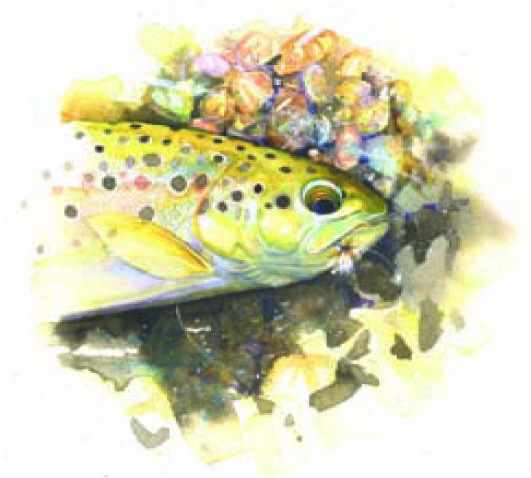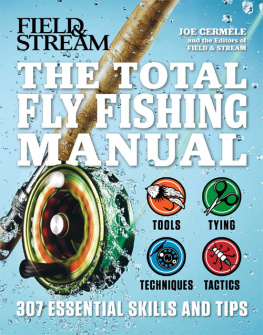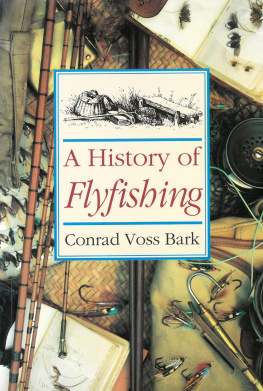INTRODUCTION

Not long ago I was on the Motueka River in the north of New Zealands South Island. At the beginning of that April day, my friend Felix and I had enjoyed modest success drifting nymph patterns deep in the faster runs. However, as the hours passed the early chill faded. We decided it was time to stop nymph fishing and drive upriver, searching for the dimples of trout rising to mayfly in the long flat pools by the roadside. After a couple of kilometres we found such a pool. Even from up on the road we could see at least a dozen trout swirling and sipping away. Unfortunately though, the pool was already taken. As we watched, a spin fisher appeared from beneath a poplar tree, threw his lure right across the densest concentration of fish and urgently cranked it back. We should have kept driving and found some fish of our own, but the sight of so many trout feeding so perfectly exerted a primal pull, and we watched for several minutes as the spin fisher reeled cast after harmless cast through the rises.
As certain as the flow of the river, the spinners attempts were futile. I understood this fundamental fact because similar experiences, multiplied by hundreds, were what persuaded me to take up flyfishing so many years ago. Unless the stranger accidentally jagged a trout, I knew he wouldnt catch one. The fish were blind to anything but the small insects (probably mayfly) drifting down the current, and nothing but a fly would fool them.
I guess part of the reason Felix and I watched for as long as we did was the hope the spin fisher would give up and leave the pool to us. But when he made his third lure change, we grudgingly accepted this was an unlikely outcome, and so we drove off again to find a stretch of our own.
Fortunately, about a kilometre further upstream, we found an even better pool. We could glimpse the odd rise from the road through gaps in the yellowing willows, but it was only when we actually walked down to the rivers edge and had a clear view of the 300-metre-long pool that we realised what wed found. Never mind a dozen trout, there must have been hundreds rising along the length, and across a good deal of the breadth, of the pool. The cause of the frenzy was an endless stream of little blue-grey mayfly duns.
I strode to the river and tied on a size 14 Parachute Adams, which seemed a good approximation of the naturals. It turned out the fly pattern was right but the size wasnt. As often happens when trout are feeding on thousands of the one kind of bug, they form quite a clear image of what the next one should look likeand size 14 was one size too big. Fortunately I wasnt stubborn enough to persist once the fly was rejected a few times. A change to a size 16 was like changing from cabbage to crayfish, and I was soon catching, or at least fooling, one trout after the other.
With the right fly, presented properly, the fishing over the next few hours was about as good as it gets. The wind stayed away and the river drifted past, delivering an endless supply of duns which the fish patiently sucked down. The trout graded from small ones of a pound or so in the shallows almost at my feet, to a few under the autumn-tinted willows on the far side that looked several times heavier. I made some attempts to wade through the 3-to 4-pounders in the middle to cast to those monsters, but never quite made it. I suppose on some level I couldnt bring myself to spook fish I would normally crawl through blackberries for.
Once or twice between fish, I caught myself thinking about the spin fisher downstream. I wanted him to see this, to understand what was possible with a fly rod. I wasnt driven by a desire to show off: Ive long ago learned that pride is a feeling to manage with great care when flyfishinggrateful satisfaction is a much safer option! It was more about knowing that, right there and then, there was no better way yet devised of fishing with a rod and I wanted even a stranger to have the opportunity to understand that.
In the event, the stranger never appeared. I imagine he eventually headed sadly home to tell anyone who listened about his encounter with dozens of uncatchable trout. But had he wandered down, and asked, What are you getting em on mate? I would have firstly showed him the tiny fly. And then the flyfishing system I was using to deliver it.
Some people will try to tell you (if they havent already) that flyfishing is an unnecessarily complicated way of catching fisha sort of artificially created obstacle course for those who find other ways of fishing too easy. In fact, there is no other method of fishing that can mimic such a broad range of things fish feed on. On the Motueka that day with Felix, only flyfishing had any hope of working. Try bait fishing with a size 16 dun or casting a lure which resembles and behaves like a mayfly nymph. It cant be done.
Its part of flyfishing lore that the first European records of flyfishing (the better part of 1800 years old) describe Macedonians fishing for trout taking mayfly. Its a fair guess that the anglers of this era were interested primarily in acquiring food to eat, not sport. But because real mayflies couldnt be threaded onto a hook, they made pretend ones out of feathers. The results looked, and crucially behaved, like mayfly enough to fool the trout. Almost two millennia on, flyfishing is still the only way of fooling trout feeding on Motueka mayfly, and the most effective way of catching trout doing a lot of other things too.
This is probably a good time to address some of the imprecision that comes with flyfishing. One of my friends, who catches more fish than most, treats flyfishing very much as a sport. He approaches most challenges from the angle of physics or biology, and he considers quantitiesthe size and number of fish caughtas a pretty good measure of success. However another mate hardly thinks at all when flyfishing, drifting instead into a hunting state when casting, looking for fish, even choosing flies. Everything occurs almost intuitively. Hes just as successful as the first guy, although hes more inclined to choose less tangible elements, like scenery, outwitting a particularly difficult fish or finding a snug campsite, as the makings of a good day.
The way in which two different approaches can both be right is a thread that winds right through flyfishing. This is a point of frustration for some first coming to grips with the sport, who would rather there was a sort of prescriptive manual: this way is right, and that way is wrong. But ultimately, I like the fact that you can enjoy a cuppa with a whole group of experts after a long day on the water without any of them agreeing on, say, what the best fly was. I also like that, in almost any flyfishing situation you can imagine, there is probably a better way of catching a fish on a fly than has so far been devised.
Its said that more has been written about flyfishing than any other sport. I have absolutely no idea if this is true or not, but if it is, at least part of the reason is covered in the preceding paragraph. This is an activity that defies simple evaluation. Perhaps last Sunday you caught more fish after you changed to a Wee Creek Hopper. But was it the actual fly change that did the trick or a coincidental change in conditionspossibly an increase in real grasshoppers on the water, or a subtle upward shift in water temperature that spurred the trouts metabolism? Could it even be that you suddenly felt more confident when you plucked this earlier overlooked pattern from your box, and therefore fished more carefully and expectantly? Such variables cut across virtually every aspect of the sport and drive flyfishing analysts mad. Even those like me, who accept and indeed quite like the mismatch between accounting and flyfishing, are left scratching our chins from time to time and wondering.







